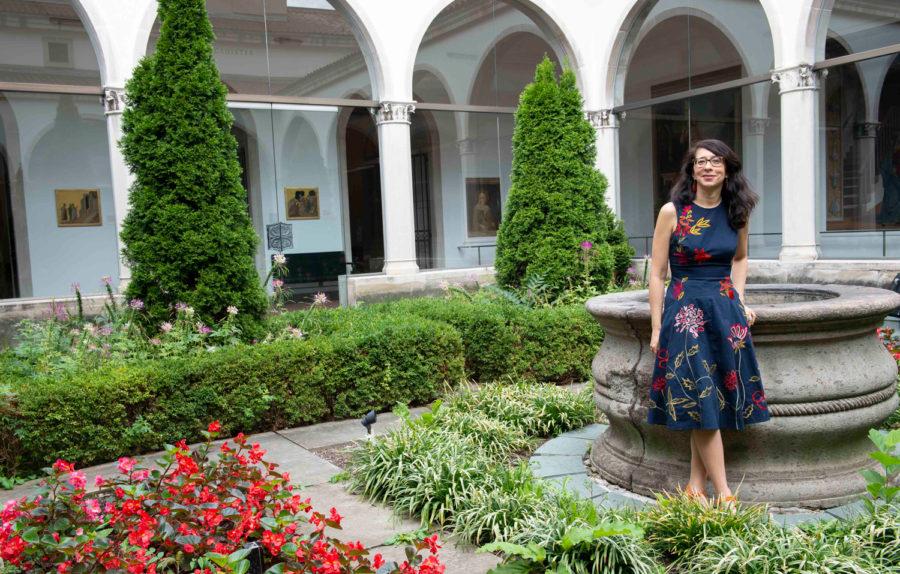Sylvia Rhor curates arts with academics
Image via University of Pittsburgh
Sylvia Rhor’s responsibilities as curator and director of Pitt’s University Art Gallery involve managing the collection’s care, curating exhibitions and touring visiting groups.
March 7, 2019
Sylvia Rhor is the curator and director of Pitt’s University Art Gallery in the Frick Fine Arts building, where she organizes collections and creates exhibitions for the public — something she never dreamed of doing as a child.
“I always say to people, it’s funny I took this path because I was not raised in a museum-going family,” Rhor said. “I’m the daughter of immigrants [from Ecuador] and we just didn’t go to museums a lot.”
As an undergraduate at NYU, Rhor started off as a studio art major, but when she had to take an art history class for her major requirement, her passion for museum studies was born. She later went on to study history of art as a graduate student at Pitt.
“I never even thought about art history or museums before that class, and all of a sudden it was like a lightbulb went off and I was like, ‘Oh my gosh, this is more what I like,’” Rhor said. “I started to become more interested in museums and art history at that point. Now, I’m totally committed, but it’s still kind of new to my family.”
Rhor has been the director for about six months now, shifting between roles of managing collections, curating exhibitions, creating academic initiatives and touring visiting groups. She said the collection currently consists of around 3,000 objects across different times and cultures, so ensuring they remain in good condition is very important.
Before coming to Pitt, Rhor taught art history at Carlow University and started the first university art gallery there. She said that gallery was dedicated to professional artists, but incorporated a social justice theme, which is a philosophy she’s since carried over to Pitt’s gallery.
“I believe it’s really important for a UAG in particular to be almost like a town square for critical discourse or to bring up different issues,” Rhor said.
To foster engaging discussions around social justice issues, Rhor started a program called Gallery Conversations, where faculty members and community members could ask questions about how certain political or social movements relate to art.
For instance, Rhor said she recently held a panel that tackled the question of what it means to display art and art history in the era of #MeToo. The academic curator of the UAG, Alex Taylor, who is also an assistant professor in the history of art and architecture department, also spoke about an exhibit titled “This Is Not Ideal” that was held in the gallery that, similar to the #MeToo panel, addressed issues of gender stereotypes and representation.
But Rhor said there is a careful balance between creating a safe and inclusive environment for students while also promoting a little bit of discomfort.
“It’s really important to be aware of what our responsibilities are as a part of a university structure and as educators,” Rhor said. “For example, with ‘This Is Not Ideal’ there were some controversial images, so I made sure to talk to the Title IX office and make sure that we properly wrote important messages and had resources for people.”
Taylor said he thinks the potentially controversial nature of social justice topics is important to incorporate into a university setting. He believes art and old artifacts can actually help people better understand societal issues today.
“The idea is really to use historical collections to think through very current issues and see what art and cultural materials have to say about those contemporary issues,” Taylor said. “I think finding ways to incorporate those urging questions of our time into the department and the gallery’s activities is something we’re all very keen to do.”
Rhor said the gallery is very traditional in the sense that it was founded on standard notions of collecting and art display, but she thinks this traditional space is perfect for displaying artwork and installations that are contemporary and also reflect on the past.
“I was just thinking about doing a video installation, and one of our graduate students is curating a Chinese contemporary video art show in the fall,” Rhor said. “So we’re definitely mixing it up.”
Rhor also wants to mix things up by reaching out to other schools and departments at Pitt and offer her gallery as a learning tool for a variety of disciplines. Recently, the gallery started Spanish languages tours where Spanish classes can practice their language skills. But she finds the vast majority of students and professors she encounters often say they were not even aware the gallery existed before. Rhor’s goal is for the UAG to become more prominent on campus and serve as a resource across curricula.
“I want anyone to feel like they can walk in whether they know a lot about art or nothing at all,” Rhor said. “I want both of those types of people to be really comfortable here. It’s not just about coming in and learning. I feel like everyone who walks in here has a story and something to add. So I want more student advisory panels, I want more input from the community. I want to open those doors.”
Kirk Savage, a professor in the history of art and architecture department, has known Rhor since she was a graduate student at Pitt 25 years ago. He strongly advocated for her to be hired as the director and currently works closely on projects with her at the gallery. He described Rhor as focused on fostering a very inclusive, collaborative environment, and being very enthusiastic about her work.
“She encourages people to share their opinions and she’s very respectful of other people’s views,” Savage said. “She’s not really self-oriented. It’s not about her. It’s about the gallery, it’s about the students.”
Rhor explained that the UAG, as opposed to other art museums like the Carnegie Museum of Art, is especially different in that it is centered on teaching. For instance, studio art students are allowed to curate certain exhibits to gain hands-on experience.
“I think of this gallery as between classroom and museum,” Rhor said. “It’s a professional art gallery, but we use it to mentor or teach. So everything we do has a pedagogical or teaching [approach].”
Rhor said she is drawn to discussion and discourse and wants more people to utilize the UAG as a resource for learning and contemplation.
“I don’t do anything just for controversy, but I’m an educator at heart,” Rhor said. “I definitely want to create a space that makes people think and reflect.”








